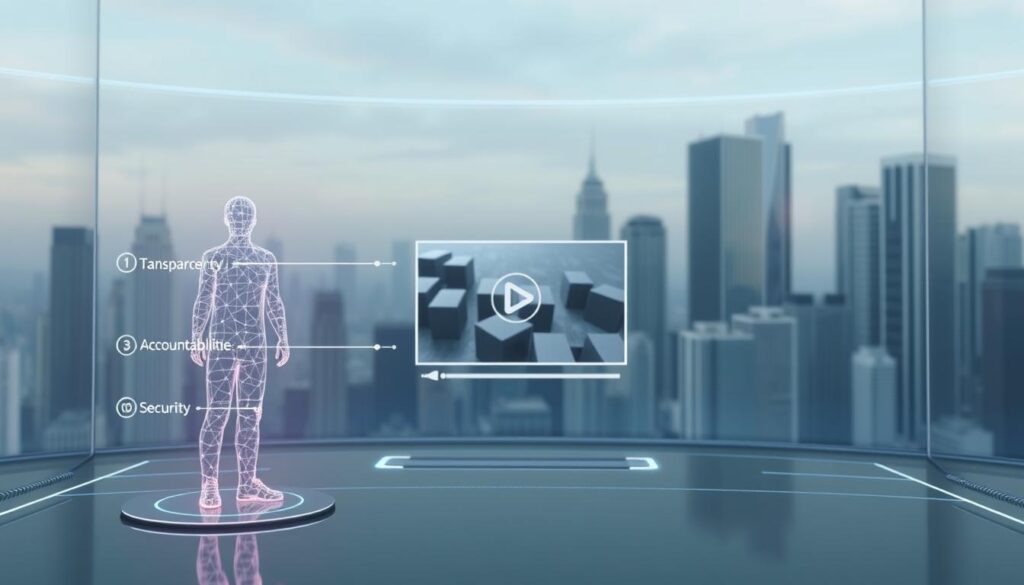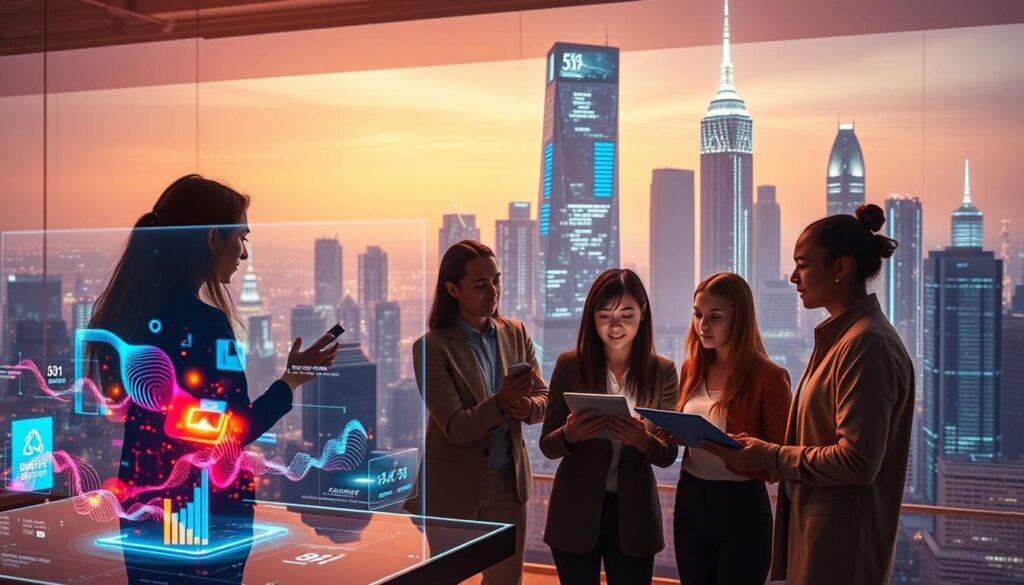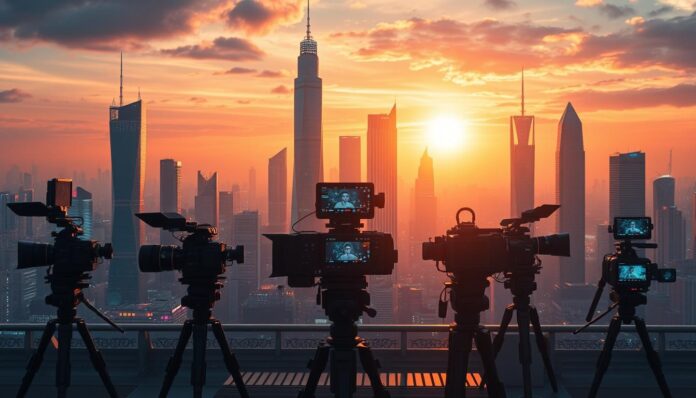Imagine your videos changing to fit what each viewer likes and needs, all by themselves. That’s what AI Video does. It’s changing how we make and watch videos, from ads to learning materials.
Before, making videos took a lot of time, money, and tech skills. But AI Video lets businesses make lots of personalized content easily. Tools like Adobe Sensei and Runway ML use smart algorithms to edit videos, suggest changes, and even make new footage from text.
A 2023 report says these tools can cut production time by up to 40%. Why is this important? Today’s viewers want content that’s quick and just for them. AI makes that happen faster than ever.
Key Takeaways
- AI Video reduces production time while improving personalization.
- Leading brands use AI to create engaging content at scale.
- Artificial intelligence in video production lowers costs for businesses.
- Over 60% of marketers plan to adopt AI Video tools by 2025.
- AI-driven visuals boost audience engagement by up to 35%.
The Evolution of AI Video Technology
AI Video technology has changed how we make and share visual content. It started with early computer vision research. Now, AI is used in film editing and creating real-time graphics. Advances in neural networks and deep learning have been crucial.
History and Development
In the 1980s, researchers began studying basic image recognition. By the 2010s, NVIDIA led the way with GPU-based neural networks. This made video processing faster and more accurate.
Key Milestones in AI Video
- 2014: Generative Adversarial Networks (GANs) allowed AI to create realistic video frames.
- 2017: Deepfake technology showed AI’s power to alter video content, raising ethical questions.
- 2020: Real-time AI video tools became common, cutting editing times by 50% in some cases.
Future Trends in AI Video
Future advancements will focus on three main areas:
- Hyper-personalization: AI Video will tailor content to each viewer’s behavior in real time.
- Automated workflows: AI-driven video production will cut manual work by 70%.
- Immersive integration: AI will blend with augmented and virtual reality, creating new experiences.
How AI Video Enhances Content Creation
AI is changing how businesses make and share videos. Tools that automate video content save money and time. This lets you focus more on being creative. These technologies make your work more efficient, personal, and engaging for your audience.
Streamlining Production Processes
Old video making methods take a lot of time. AI makes key steps like writing scripts and editing easier. Tools like CapCut and InVideo use AI to make things simpler:
| Task | Manual Process | AI-Powereded Approach |
|---|---|---|
| Scriptwriting | Hours of brainstorming | AI generates drafts in minutes |
| Editing | Manual clip trimming | Automated transitions and music syncing |
Crafting Personalized Experiences
AI looks at what viewers like to make videos just for them. Sites like Wibbitz use smart tech to match content to what people want. For instance:
- Netflix uses AI to suggest shows, and similar tech can make videos for you
- E-commerce sites like Sephora make special tutorials based on what you buy
Increasing Engagement Rates
Brands using AI see their videos get watched 30% more. Video automation means videos go live on time. Dynamic content keeps viewers interested. Key ways include:
- Testing different video thumbnails automatically
- Adding captions in real-time for everyone to see and for SEO
Platforms like Lumen5 say AI-optimized videos get 40% more clicks.
The Role of AI in Video Editing
AI is changing how we edit videos, making it faster and smarter. Video editing with AI technology means you can do more creative work. These tools save time and improve video quality.
Automated Editing Tools
AI tools make editing easier with features like scene detection and auto-cut suggestions. Here’s what top tools offer:
| Feature | Tools |
|---|---|
| Smart Scene Detection | Adobe Premiere Rush |
| Auto-Color Grading | CapCut, Filmora |
| Content-Aware Edits | Premiere Pro |
Enhancing Visual Effects
AI makes VFX easier, no longer needing experts. Tools like DaVinci Resolve’s Neural Engine can:
- Remove objects automatically
- Replace backgrounds seamlessly
- Add motion tracking effects
Improving Sound Quality
AI improves audio by:
- Reducing background noise (Adobe Audition)
- Improving voice clarity (iZotope RX)
- Creating matching music
These tools help turn raw footage into great videos, without needing to learn complex software.
Applications of AI Video Across Industries
AI Video is changing the game for businesses. It helps them make videos better with artificial intelligence. This technology is making a big splash in many areas, from getting customers more engaged to changing how we learn.
Marketing and Advertising
Brands are now making ads that really speak to people. Tools like Adobe Sensei and IBM Watson look at what people like and make ads on the spot. For example, Coca-Cola made 10,000 different ads for 2023. This made people click on ads 22% more often.
- Automated ad localization for global markets
- Dynamic video content for real-time audience preferences
Education and E-Learning
Universities and sites like Coursera are using AI Video to make learning better. MIT’s Open Learning program adjusts videos to fit how well students are doing. This has helped students finish their courses 35% more often. As one expert says:
“AI-driven video personalization is closing the achievement gap in education.” – Dr. Emily Chen, Stanford Learning Sciences Lab
Entertainment and Media
Netflix and Disney+ are using AI Video to guess what viewers will like. This cuts down the time it takes to find something to watch by 40%. AI is also speeding up movie editing. Warner Bros. made a huge hit in half the usual time with AI tools. Some key uses are:
- Algorithmic content recommendations increasing viewer retention
- Automated color grading and special effects in post-production
AI Video is helping industries do more with less. It’s making ads better, learning more personal, and movies bigger than ever.
Popular AI Video Tools and Software
Choosing the right AI tools for video creation depends on your goals and budget. Look at top platforms that make production easier. They are great for marketers, educators, and content creators.
Overview of Leading Platforms
- Adobe Premiere Rush: Offers professional editing with AI for color correction and clip suggestions.
- Canva: Has easy-to-use templates for quick AI-powered video creation, perfect for social media.
- InVideo: Uses drag-and-drop automation for corporate presentations and ads.
- Pictory: Specializes in video personalization for e-commerce and email campaigns.
Comparing Features and Pricing
Key differences are in automation levels and cost:
- Features: Some tools focus on auto-editing, while others are great for stock footage.
- Pricing: Free tiers are available, but advanced AI features need paid subscriptions (e.g., $19.99/month for InVideo Pro).
- Limitations: Basic plans might limit export resolution or clip duration.
User Reviews and Recommendations
“Pictory’s AI voiceover tool cut my production time by 50%.” — Marketing Manager, Tech Startup
For AI tools for video creation, consider:
- Beginners: Start with Canva’s easy interface.
- Professionals: Try Adobe’s advanced editing suite.
- Budget-conscious users: Check out InVideo’s free tier for short projects.
Look at user testimonials to match your team’s skills and vision.
Ethical Considerations of AI Video

As AI Video changes how we make content, we face big ethical questions. We must protect user privacy and stop the wrong use of artificial intelligence in video production. This is key to keeping trust and following the law.
Privacy and Data Security
AI Video systems gather data to make content more personal. To keep privacy safe, we need to be open about how we use data. Use encryption and tools that hide identities to lower risks.
Is it clear when users give consent? Are our data storage rules strict and safe?
Misinformation and Deepfakes
“Deepfakes can blur reality, making ethical guidelines essential for creators.” – Tech Ethics Council
Tools like facial recognition and fake media are causing worries. Use tech to check if content is real. Follow ethical AI Video rules to stop misuse in ads or politics.
Compliance and Regulations
- Follow GDPR and CCPA rules when handling user data.
- Keep up with new laws on AI-made media.
- Update policies as laws change.
Being ethical with AI Video means finding a balance between new ideas and being responsible. By tackling these issues, your artificial intelligence in video production will meet legal standards and earn public trust.
Integrating AI Video into Your Strategy
Starting with AI video tools needs a solid plan. First, identify your team’s challenges. Ask yourself: Where do manual tasks slow us down? Which creative goals need advanced help?
Use this analysis to pick AI tools for video creation. Look for tools that help with editing, personalization, or distribution.
Assessing Your Needs
Start with a workflow audit. Map out each step of your current process. Highlight tasks like color correction or voice-over generation.
Tools like Adobe Premiere Pro’s AI features or Runway ML’s automation can help. Choose tools that match your content goals, like boosting engagement or saving time.
Budgeting for AI Tools
Costs go beyond just subscription fees. Consider staff training, software licenses, and setup downtime. Platforms like Descript or Lumen5 offer different pricing levels. Find the best fit for your budget.
Set aside money for ROI analysis. This will show the long-term benefits of using AI in video creation.
Measuring Success
Keep track of metrics like video completion rates or production speed. Use dashboards to see improvements. For example, check how AI-generated thumbnails increase click-through rates.
Share your findings with stakeholders. Use reports to show cost savings and creative enhancements.
The Future of AI Video in Marketing

Marketing is changing fast with machine learning in video editing and video content automation. These tools help analyze data, personalize content, and run big campaigns. They make it easier to see how well your efforts are working.
Data-Driven Decision Making
Machine learning in video editing looks at how people watch videos to find out what they like. It checks things like how many clicks and how long people watch. This helps brands know what works best.
Tools like Adobe Sensei or Premiere Pro’s AI features can spot trends. They help you make your videos even better for your audience.
Targeted Campaigns with AI Insights
Platforms like Wibbitz or Kapost make it easy to create ads for different places in minutes. Imagine a car company making ads for the whole world. AI changes the video to fit what people in each area like.
A 2023 study by Forrester showed that using this method can double engagement.
Case Studies of Successful AI Video
- A luxury skincare brand cut production time by 60% with automated tools. This let them make more ads for different people.
- A global retailer made personalized product demos with AI. This led to a 35% increase in online sales.
- A tech company used AI to make ads better. They saw a 22% jump in people buying things.
These stories show how important AI video strategies are getting. Using these tools, your brand can stay ahead of the game.
Conclusion: Embracing AI Video Technology
AI-driven video production is changing the game in many fields. It’s essential for businesses and creators to get on board. This tech brings real benefits for those aiming to succeed in a world where visuals matter most.
Understanding the Benefits
AI tools for making videos cut down on production time and boost creativity. Tools like Adobe Premiere Pro and Canva’s AI features make editing easier. This lets teams focus on the big picture, not just the technical stuff.
AI also helps create content that speaks directly to viewers. It turns complex ideas into stories that grab attention. This makes videos more engaging and effective.
The Importance of Staying Current
AI technology is always getting better, so you need to keep learning. Stay updated by reading industry news or attending webinars. This way, you’ll know about new tools and techniques before others do.
Joining communities like the Adobe Creative Cloud forum or Canva’s design blog is also key. It helps you stay ahead of the curve and avoid being left behind.
Next Steps for Implementation
First, review your current workflow to see where AI can help. Try out free trials of tools like CapCut or Lumen5 to see how they work. This will give you a feel for how AI can streamline your process.
Set aside a small budget for training your team on AI tools. This will help them adapt smoothly without feeling overwhelmed. Keep an eye on how well your videos are doing by tracking viewer retention. Use this data to improve your approach over time.

